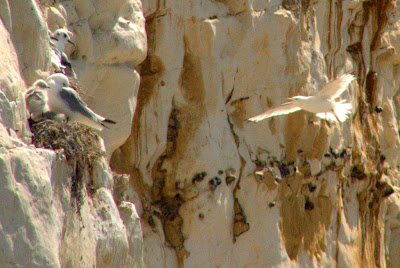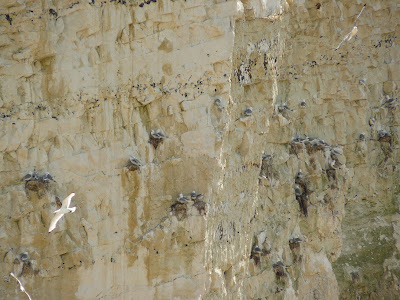There are two more blog entries below from Karlstadt.
Meanwhile, here are some insect pictures to enjoy. Click to expand them.
A cricket.
On a windy day like this one it is difficult to photograph flowers and butterflies when they are swaying in the wind. Just look, above, at this fine example of innovative German engineering!
It works! Thank you Franz.
What a paradise for butterfly enthusiasts; Swallowtail butterflies were almost common!
For illustrated talks on natural history and history see www.peterlovetttalks.co.uk
For illustrated talks on natural history and history click here for www.peterlovetttalks.co.uk
Thursday, 28 July 2011
Karlheinz's walk above Karlstadt through forest and vineyards
Karlheinze's walk lead us through a forest bird nature reserve and along a national long distance trail.
A Marbled white butterfly above.
Click on any picture to enlarge it.
The view towards Würzburg.
The river Main and view to Würzburg.
L to R, Karlheinz, Silvia, Franz, Gloria & Devi.
Chalkhill blue butterflies mating (female on top), which gives a clue to the alkaline nature of these steep hillsides.
The same pair (with the male on the left) in a horizontal position.
A rare sight of a Red-tailed bumblebee queen mating with the smaller male.
To give you an idea of the size of these bees, I let them walk over my hand.
The vineyards here are too steep for any tractor to climb.
Ploughs, like the one above, are pulled up the slopes by a cable and winch from a vehicle on the roadway.
A plough and view of a lock on the river.
Looking north to Karlstadt and its cement works.
Just look at this display board. What a great reason to return in May-June.
Thank you Karlheinz for such a great walk.
A Marbled white butterfly above.
Click on any picture to enlarge it.
The view towards Würzburg.
The river Main and view to Würzburg.
L to R, Karlheinz, Silvia, Franz, Gloria & Devi.
Chalkhill blue butterflies mating (female on top), which gives a clue to the alkaline nature of these steep hillsides.
The same pair (with the male on the left) in a horizontal position.
A rare sight of a Red-tailed bumblebee queen mating with the smaller male.
To give you an idea of the size of these bees, I let them walk over my hand.
The vineyards here are too steep for any tractor to climb.
Ploughs, like the one above, are pulled up the slopes by a cable and winch from a vehicle on the roadway.
A plough and view of a lock on the river.
Looking north to Karlstadt and its cement works.
Just look at this display board. What a great reason to return in May-June.
Thank you Karlheinz for such a great walk.
Tuesday, 26 July 2011
Swallowtails in Karlstadt, Germany, 24 July 2011
Karlstadt is a well preserved medieval walled town in northern Bavaria.
Swallows nest under the overhang of this old building.
On the otherside of the river Main, high on the cliff and behind the ruined castle were more Swallowtails.
This is the view from the ruined castle...... behind which was
a Swallowtail butterfly. What a beauty, even if one of its "tails" is broken off.
Swallows nest under the overhang of this old building.
On the otherside of the river Main, high on the cliff and behind the ruined castle were more Swallowtails.
This is the view from the ruined castle...... behind which was
a Swallowtail butterfly. What a beauty, even if one of its "tails" is broken off.
Tuesday, 19 July 2011
Seaford Head, the Seven Sisters and wading the Cuckmere river at low tide.
After watching the nesting Kittiwakes at Seaford Head this group from Mid Sussex Ramblers headed off up the Headland.
The visibility was crystal clear with views back to Seaford, to Newhaven and beyond to Brighton. Click to expand the picture.
We had met at East Dean and taken the bus to Seaford from whence we started to walk back to Cuckmere Haven and over the Seven Sisters.
Descending Seaford Head, there are iconic views of the Seven Sisters.
At the beach at Cuckmere Haven there are two choices;
Ian and Malcolm acted as "safety officers" to prevent any drownings. As leader, I took photo's to show our elaborate safety precautions, whilst still ready to rush forth and pluck drowning souls from the raging, icy torrent.
L to R, Malcolm and Ian, stood in the foaming currents, solid like English Oaks, and guided the group safely across the river.
An exciting time was had by all.
Then it just remained to replace our boots and to head off over the Seven Sisters.
What fun!
There are further very fine pictures from this walk from Janice at http://picasaweb.google.com/janicetipping/RamblersWalkFromSeafordtoEastDean
The visibility was crystal clear with views back to Seaford, to Newhaven and beyond to Brighton. Click to expand the picture.
We had met at East Dean and taken the bus to Seaford from whence we started to walk back to Cuckmere Haven and over the Seven Sisters.
Descending Seaford Head, there are iconic views of the Seven Sisters.
At the beach at Cuckmere Haven there are two choices;
- Walk up the side of the river for a mile or so to cross on the road bridge, or:
- wade the river....
Ian and Malcolm acted as "safety officers" to prevent any drownings. As leader, I took photo's to show our elaborate safety precautions, whilst still ready to rush forth and pluck drowning souls from the raging, icy torrent.
L to R, Malcolm and Ian, stood in the foaming currents, solid like English Oaks, and guided the group safely across the river.
An exciting time was had by all.
Then it just remained to replace our boots and to head off over the Seven Sisters.
What fun!
There are further very fine pictures from this walk from Janice at http://picasaweb.google.com/janicetipping/RamblersWalkFromSeafordtoEastDean
Kittiwakes at Seaford Head today.
I'm hungry... where is my lunch? A cry from this baby Kittiwake at Seaford Head.
One parent looks fast asleep. Any human parent will know that feeling!
Is this the other parent back from the sea, ready to regurgitate some part digested fish?
This is the view from Splash Point at Seaford Head, from where the above pictures were taken.
Click on any picture to expand it.
One parent looks fast asleep. Any human parent will know that feeling!
Is this the other parent back from the sea, ready to regurgitate some part digested fish?
This is the view from Splash Point at Seaford Head, from where the above pictures were taken.
Click on any picture to expand it.
This walk, lead by me, was from the Mid Sussex Ramblers programme of walks. The next exciting sections of the walk will follow shortly.
The small gull in the center of the above picture is a Kittiwake.
Monday, 11 July 2011
Flying ants, black garden ants - Lasius Niger - & the insects' annual mating ritual
There were a couple of frenetic sexual orgies in my garden this evening whilst I was having an early dinner. Flying ants; black ant females were emerging in their hundreds for just a few minutes before calm was restored and the males returned underground once the queens had all flown away.
There is a good article on this at http://news.bbc.co.uk/1/hi/magazine/7525028.stm
Meanwhile here are some pic's.
Subscribe to:
Comments (Atom)
Blog Archive
-
▼
2011
(104)
-
▼
July
(8)
- Some more insect pictures from Karlstadt; assisted...
- Karlheinz's walk above Karlstadt through forest an...
- Swallowtails in Karlstadt, Germany, 24 July 2011
- Seaford Head, the Seven Sisters and wading the Cuc...
- Kittiwakes at Seaford Head today.
- Flying ants, black garden ants - Lasius Niger - & ...
- Path Clearing on the High Weald Landscape Trail ne...
- Common Broomrape on 9 miles stroll from Tattenham ...
-
▼
July
(8)

















































